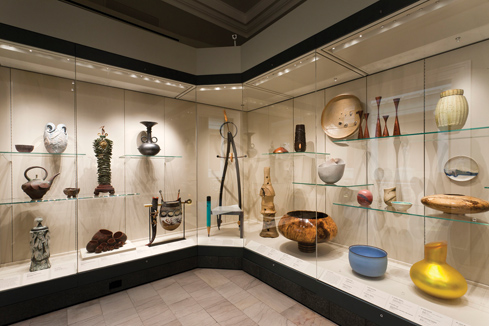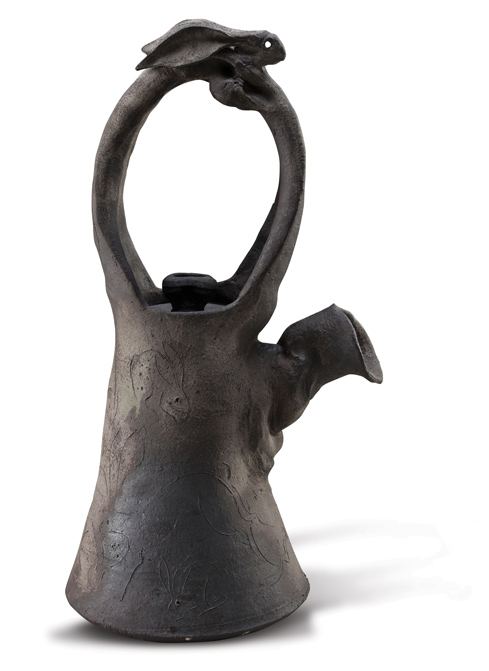 Winter 2011
Winter 2011|
“We’re happy that the work ended up in a real solid institution that is well-endowed and vibrant.”
- Jerome Kaplan
|
Contemporary Craft
Carnegie Museum of Art once again showcases its rich collection of decorative arts, this time with an emphasis on Modernist and contemporary design and craft.
To learn about Carnegie Museum of Art’s growing reputation in the world of contemporary craft, take a seat. Or rather, take in the contempor-ary interpretations of studio furniture and other three-dimensional art in media ranging from flame-worked Pyrex to finely turned American hardwoods on view in Hand Made: Contemporary Craft in Ceramic, Glass, and Wood, the inaugural exhibition of The Charity Randall Gallery. Long ago a lounge and most recently the Treasure Room, the reimagined alcove off of the Hall of Sculpture balcony is now The Charity Randall Gallery, thanks to generous support from The Charity Randall Foundation. An elegant venue with large floor-to-ceiling built-in glass cases lit with fiber optics, it features 70 objects—more than half of which are new to the museum’s collection—by contemporary American and European craftsmen. The exhibition extends into the adjacent Hall of Sculpture balcony, the Ailsa Mellon Bruce Galleries, and the museum’s lower lobby; another 75 works are on view in these spaces, many for the first time. “In the last few years, we’ve been making a concerted effort to develop the craft areas of the collection,” explains Rachel Delphia, the museum’s associate curator of decorative arts and design and curator of Hand Made. While clay made early inroads in the art world in the 20th century, she says, glass has been a focus for only a few decades, and turned wood has gained interest even more recently. In addition to other recent acquisitions in all three media, this past June the museum received a major gift of 23 works from the large contemporary craft collection of Jerome and Deena Kaplan of Bethesda, Maryland. The monumental gift, the couple’s first to a museum, comprises the largest single donation to Carnegie Museum of Art’s decorative arts and design collection over the past decade. “It’s wonderful when collectors see an opportunity to create a legacy,” says Delphia. The Kaplans could very well have donated their collection to a nearby museum in Washington, D.C., such as the Smithsonian’s Renwick Gallery, which showcases American crafts. But the couple wanted to make sure that the works they donated wouldn’t be consigned to an archive, and they were intrigued by Carnegie Museum of Art’s collection. “We wanted the work to be seen,” says Deena Kaplan. The couple first met Jason T. Busch, Carnegie Museum of Art’s curatorial chair for collections and The Alan G. and Jane A. Lehman Curator of Decorative Arts and Design, at the annual Chicago art fair Sculpture Objects and Functional Art (SOFA). After Busch visited their home, the Kaplans invited him to make a “wish list” of objects in their collection and made a trip to Pittsburgh. Of the combined selections of Busch and Delphia, 23 works were donated by the Kaplans. “We visited the Museum of Art and loved it,” Deena continues. “It had a promising program in three-dimensional art.” Her husband concurs. “We’re happy that the work ended up in a real solid institution that is well-endowed and vibrant,” he says. The pair’s donation bespeaks a taste for fine materials and witty interpretation. “We’ve always collected things that have some humor in them,” adds Jerome. The Kaplans began their collection more than 15 years ago with large pieces, such as the Double Rocking Chair by legendary American furniture maker Sam Maloof and Judy Kensley McKie’s whimsical Monkey Settee, both of which they donated. “We like happy things—not torturous or Pop art,” adds Deena. And as their collection grew to more than 300 works, it became more difficult to keep them on view.
Delphia notes that visual affinities, rather than media, dictate the display in the newly renovated gallery. The sensuous lines of Dale Chihuly’s Oxblood and Blue Persian Set with Red Lip Wraps emphasize its frilled contour of glass, while a small nearby porcelain sculpture, Ursula Morley Price’s Crow, suggests outstretched bird wings in its radial lines. A nearby touchscreen amplifies the themes of the collection, from materiality to what Delphia calls “technical fetishism.” She refers to the artists’ intense patience and attention to detail, apparent in the delicate knife-edges of porcelain, or the explorations of positive and negative space in tiny wooden spirals. The familiar form of the chair is radically reinterpreted in the new acquisitions, strengthening the museum’s 200 holdings in the genre. Among the Kaplan gifts are five variations on seating. Sit…, a translucent straight-backed chair of webbed Pyrex by Brent Kee Young, appears to float in a corner display case. A few feet away, the colorful Architect’s Valet by Alphonse Mattia improvises a chair back from an oversized drawing compass. In the nearby Bruce Galleries, the Double Rocking Chair and Monkey Settee stand out with sleek wooden lines and functional form; their sense of humor echoed by John Cederquist’s The Three Escape Attempts of the Marquis de Side chair, with dyed spikes and shapes that warn away potential users. This broad range of interpretation extends to the couple’s gift of ceramics, from twists on more traditional vessels such as Kenneth Ferguson’s Hare Teapot to larger objects. Greeting visitors to the Hall of Sculpture balcony is the showy Viola Frey work Grandma with Baseball Player, mounted on a classically styled plinth. Its bright glaze and the thick, rough outlines of its figures contrast sharply with the surrounding statuary, but Delphia says the object reflects Greco-Roman style. “There’s an almost cartoonish quality to the work, but it is in the tradition of figurines, like saints and mythological figures,” she notes. This and the other objects that comprise Hand Made remind the viewer that crafts transcend function to become both art and history.
|
The ABCs of Discovery · Photographing My People · International Negotiations · The Art of Reading a Face · Director's Note · NewsWorthy · Face Time: Linda Ortenzo · About Town: Game On · The Big Picture
 |
Copyright © 2017 CARNEGIE Magazine. All rights reserved. |


